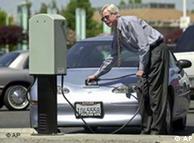Electric cars not enough to meet transport emissions targets – UK Energy Research Council warns Brits must reduce their dependency on cars to meet country’s climate targets
(Source: Guardian, UK; Photo: thingermejig @ Flickr)
Government must encourage motorists to get out of their cars and walk or cycle, say scientists
Britons must reduce their dependency on cars if the UK is to meet its climate targets, scientists warn today. In a new study they said that simply switching wholesale to cleaner or all-electric cars, as announced by the government in its low-carbon car strategy last week, would not be enough for the transport sector to cut its carbon emissions.
The report by the UK Energy Research Council (UKERC) said the government had to tackle driver behaviour as well as car technology to reduce transport emissions. That means incentivising overall changes in the way people travel by encouraging walking and cycling, for example, and also discouraging the use of cars through taxation or other levies.
Last week the government announced a £250m plan for incentives of up to £5,000 each to consumers to buy low-carbon or electric cars from 2011 to help decarbonise transport.
Speaking ahead of this week’s 2009 budget announcements, Jillian Anable, head of transport research at UKERC, said the electric car plans were welcome but not enough to tackle the transport emissions problem alone. “They’re being billed as policies to affect the low-carbon car market and that’s very one-dimensional. [The government needs] a set of policies around low-carbon transport transformation so the grants that we see need to be more widely […] targeted to low-carbon travel behaviour.”
She added: “Without managing travel patterns themselves, it is very difficult to meet the technological challenges, including how the electricity is generated, at the scale and pace required. Without effective policies to manage demand for travel, emission cuts through vehicle technology will be made much more difficult and may come too late.”
Road transport accounts for 22% of the UK’s total carbon emissions, with more than half of that coming from cars. In trying to work out how to cut these emissions, the UKERC report reviewed more than 500 international studies looking at different policies aimed at reducing carbon dioxide emissions from road transport. The scientists looked for methods and incentives that seemed to work best and where well-intentioned policies led to unintended consequences.
Friends of the Earth’s transport campaigner Tony Bosworth said the UKERC report was “further evidence that we need a green transport revolution. Low carbon cars, though important, are not enough to tackle transport’s contribution to climate change — we must also change how and how much we travel. The RAC revealed this week that people use their cars for over three quarters of journeys between two and three miles long — with proper facilities in place, there’s no reason why these journeys couldn’t easily be made by bus, bicycle or on foot.” He added: “The government must rapidly steer its transport policy in a greener direction and make alternatives to cars more attractive by improving public transport services and make walking and cycling far safer.”
A Department for Transport spokesperson said: “We agree that in order to tackle climate change we need to do more than support electric cars. That is why in addition to the £400m to encourage development and uptake of ultra-low emission vehicles, we also spend £2.5bn a year on buses, £140m on cycling and require local authorities to factor in the impact on the environment when developing their transport strategies. Tackling climate change is one of the single most important issues we face, and transport is central to how we deal with it.










